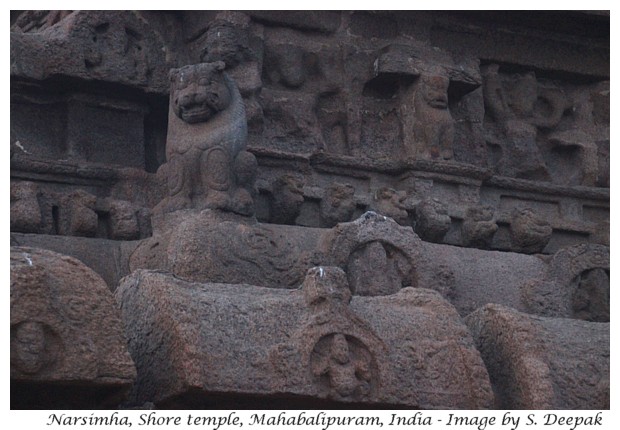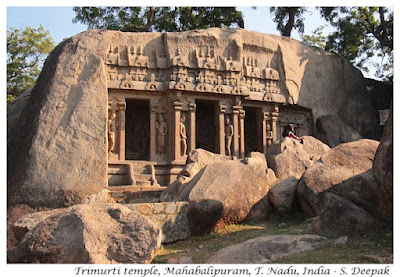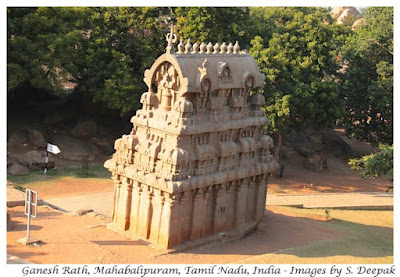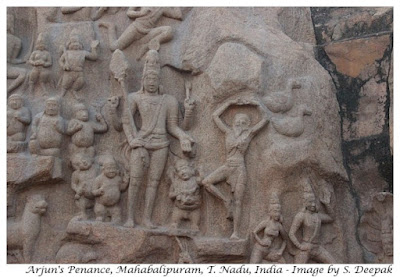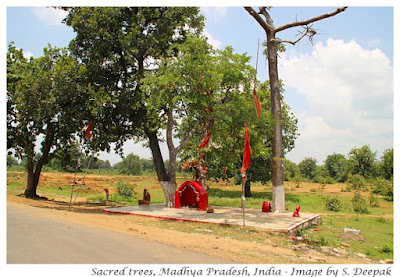Shore temple of Mahabalipuram is a magical place, especially early in the morning as the sun rises over the Bay of Bengal and illuminates the early 8th century structure. (Click on the images for a bigger view)
History of the Shore Temple
In 700 CE when Rajasimha Varman became the king of the Pallava empire with its capital in Kanchipuram, the empire was nearing the end of its power. Over the previous centuries, his ancestors had built the seafaring empire with their ships going up to Rome in the Mediterranean. In the 6-7th centuries, the Pallava kings had built a large number of sea-facing rock-temples on the granite hills of Mahabalipuram.Rajasimha ruled for 28 years and is credited with the building of the shore temple. Two new Shiva shrines were built around an older statue of reclining Vishnu. After Rajasimha, the power of Pallava kings gradually declined and in the 9th century, the area came under the Chola empire.
4 Shrines of the Shore Temple
The Shore Temple is composed of 4 distinct shrines – an eastern facing Kshatriya Simheshwar temple dedicated to Shiva; a western facing Rajasimheshwar temple also dedicated to Shiva; a partially open shrine surrounding the older statue of reclining Vishnu between the first two temples; and, an open-air step-well Shiva shrine to the north.When I visited it, the eastern sea-facing Shiva temple was closed for repairs. Even the shrine to the reclining Vishnu was closed.
Temple Complex
As you walk towards the temple, you come across two stone platforms. Usually, in the temples, there is one platform with the animal representing the vehicle of the principal deity. Perhaps, the two platforms in front of the Shore Temple indicated that the temple had two main deities (Shiva and Vishnu), though now both the platforms have lost their statues.
The outer wall of the temple complex was lined with a row of sitting Nandi bulls. After a corridor, there was an inner wall which had bass-relief panels showing Hindu mythological stories.
Narsimha Stautes in the Shore Temple
The whole area also had many statues of another animal – the Narsimha lion, that looked like a sabre-toothed tiger. The image below shows a Narsimha niche with an Apsara on his right shoulder placed facing the sea, probably used for keeping a lamp as a light-house for the sea boats. Narsimha statues clearly represent the king during whose reign this temple complex was built. Thus, I wonder, if the Apsara could have been a representation of his queen or may be a family deity?Sunrise at the Shore Temple
When I reached the Shore Temple, it was still dark and there was no one else. Going around in the morning stillness was almost like a meditation. After about 20 minutes a few other persons came. On the other hand, the beach to the south of the temple, was already full of pilgrims in their red clothes, taking bath and selfies in the morning sea, with a few tourists clicking their pictures.Youth Follies
This time, older and wiser, I spent the whole morning at the shore temple. It was an amazing visit and I will cherish the memory of this visit.
To Conclude - Sabrimala Judgement
Let me conclude this post with something completely different. The image below has a group of Sabrimala pilgrims at the smaller Shiva shrine of the Shore temple in Mahabalipuram.I believe that parliaments and courts have a role in ensuring that our religions do not violate the fundamental human rights. If some practices are systematic, then we should look at them critically. However, I don't think that special rules for one individual temple violate the human rights of faithful, it is not a systematic discrimination. Such differences are a part of the richness and diversity of Hinduism, common in the way the religious faiths are lived in India, especially for the Indic religions. Insisting on eliminating that diversity of temple practices and promoting uniformity of the religious practices is a loss for humanity and it means accepting the views of fundamentalists who ask for narrow definitions of the religious practices.
I hope that the SC judgement about Sabrimala temple will become an opportunity for people to reflect on the richness of our cultural and social diversities of Hinduism and Indic religions and find meaningful ways to safeguard this heritage for the future. If we cancel our diversities of practices, then we lead to a monoculture of faith, which are contrary to the idea of Hinduism, even if fundamentalists would like to have such a world.








